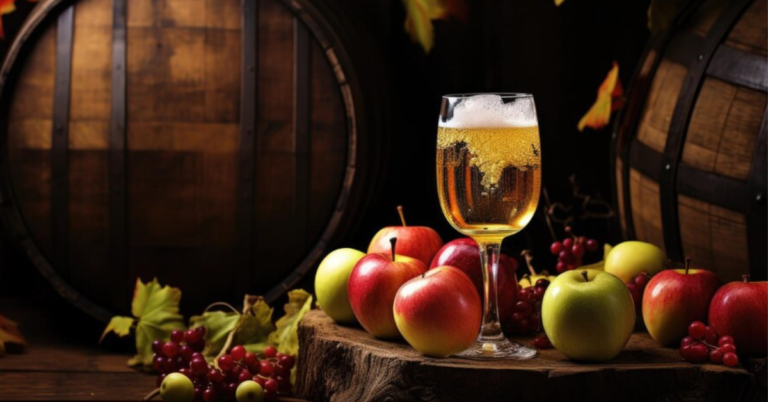Cider wine, with its rich history and diverse flavors, stands as a testament to humanity’s enduring love affair with fermented beverages. Originating from the ancient traditions of cider-making, this delightful drink has evolved over centuries, captivating palates around the globe. In this comprehensive guide, we embark on a journey to uncover the secrets behind cider wine – from its humble beginnings to its modern resurgence.
A Brief History of Cider: From Antiquity to Modernity
Origins in Antiquity
Cider wine traces its roots back to ancient civilizations, where the fermentation of apple juice was practiced as early as 55 BC in Roman-occupied England. The Romans, renowned for their viticulture, recognized the potential of the apple as a source of refreshing libations.
Medieval Europe: The Rise of Cider
During the Middle Ages, cider production flourished across Europe, particularly in regions like Normandy and Somerset. Monasteries played a crucial role in refining cider-making techniques, leading to its widespread popularity among both clergy and commoners.
Colonial America and Beyond
Cider-making crossed the Atlantic with European settlers, becoming a staple beverage in Colonial America. Apple orchards proliferated in regions such as New England, laying the groundwork for America’s own cider-making tradition.
Decline and Resurgence
The Industrial Revolution and the rise of beer and wine led to a decline in cider production. However, recent years have witnessed a resurgence of interest in artisanal cider, fueled by a growing appreciation for craft beverages and traditional methods.
The Art of Cider-Making: From Orchard to Glass
Orchard Management
The quality of cider wine begins in the orchard. Selecting the right apple varieties, maintaining orchard health, and harvesting at optimal ripeness are critical steps in ensuring a flavorful end product.
Pressing and Fermentation
Once harvested, apples are washed, crushed, and pressed to extract the juice. This juice undergoes fermentation, where natural or added yeast converts sugars into alcohol, imbuing the cider with its characteristic flavors and aromas.
Aging and Blending
Some ciders are aged in oak barrels or stainless steel tanks to enhance complexity and impart subtle nuances. Master cider makers often blend different apple varieties or fermentation batches to achieve the desired balance of sweetness, acidity, and tannins.
Bottling and Packaging
After fermentation and aging, the cider is filtered, clarified, and sometimes carbonated before being bottled or kegged for distribution. Packaging choices, such as corked bottles or cans, can influence the cider’s presentation and shelf life.
Varieties of Cider Wine
Traditional Dry Cider
Dry cider, with its crisp acidity and minimal residual sugar, appeals to those who prefer a tart, refreshing beverage. Traditional dry ciders often showcase the natural flavors of heirloom apple varieties, with subtle hints of citrus or floral notes.
Sweet and Off-Dry Ciders
Sweet and off-dry ciders cater to palates seeking a touch of sweetness. These ciders may be crafted by halting fermentation before all sugars are converted to alcohol or by blending in sweeter apple varieties or adjuncts like honey or fruit juice.
Still vs. Sparkling
Ciders can be still or sparkling, offering different drinking experiences. Still ciders maintain a smooth, non-effervescent texture, while sparkling ciders exhibit lively bubbles that tickle the palate and enhance aroma perception.
Heritage and Modern Styles
Heritage ciders, made from traditional cider apple varieties, often boast complex flavor profiles with pronounced tannins and earthy undertones. In contrast, modern ciders may incorporate non-traditional fruits, spices, or barrel aging techniques, pushing the boundaries of traditional cider-making.
Cider Wine Around the World
United Kingdom: The Heartland of Cider
England, particularly the West Country, remains synonymous with cider production. Here, centuries-old orchards and time-honored techniques converge to produce some of the world’s finest ciders, from scrumpy farmhouse brews to refined sparkling varieties.
France: Terroir and Tradition
France boasts a rich cider heritage, especially in regions like Normandy and Brittany. Here, cider-making is intertwined with wine culture, with terroir-driven ciders reflecting the nuances of local apple varieties and microclimates.
Spain: Sidra and Basque Country
In Spain, cider, known as “sidra,” holds a special place in Basque and Asturian culture. Sidra natural, a lightly effervescent, tart cider, is traditionally poured from great heights to aerate and enhance its aroma.
United States: From Coast to Coast
The United States has witnessed a cider renaissance in recent years, with artisanal producers crafting a diverse array of styles from coast to coast. Regions like the Pacific Northwest and New England are particularly renowned for their vibrant cider scenes.
The Cider Renaissance
Craft Cider Boom
The surge in craft cider popularity has spurred innovation and experimentation within the industry. Small-scale producers, often working with locally sourced ingredients, are pushing boundaries with creative flavor combinations and unconventional techniques.
Heritage Apple Revival
Efforts to preserve and revive heirloom apple varieties have gained momentum, with cider makers championing the unique flavors and aromas of these heritage fruits. Orchards dedicated to rare and forgotten apple cultivars serve as living repositories of cider history.
Food Pairing and Culinary Integration
Cider’s versatility and wide range of flavors make it an ideal companion for various cuisines and occasions. From traditional pairings with cheese and charcuterie to inventive culinary collaborations, cider’s culinary potential knows no bounds.
Sustainability and Localism
Many cider producers prioritize sustainability and localism, sourcing apples from nearby orchards, employing eco-friendly production practices, and minimizing waste through composting and recycling initiatives. By fostering connections with their communities and landscapes, cider makers are promoting environmental stewardship.
Conclusion
Cider wine stands as a testament to the timeless allure of fermented beverages. From its ancient origins to its modern renaissance, cider embodies the artistry, tradition, and innovation of the craft beverage world. Whether enjoyed on a crisp autumn day or paired with a gourmet meal, cider wine offers a taste of history and a sip of pure delight.
Whether you’re a seasoned cider aficionado or a curious newcomer, embarking on a cider-tasting journey promises to be a rewarding experience. So raise a glass, savor the complexity of flavors, and toast to the enduring legacy of cider wine. Cheers!

